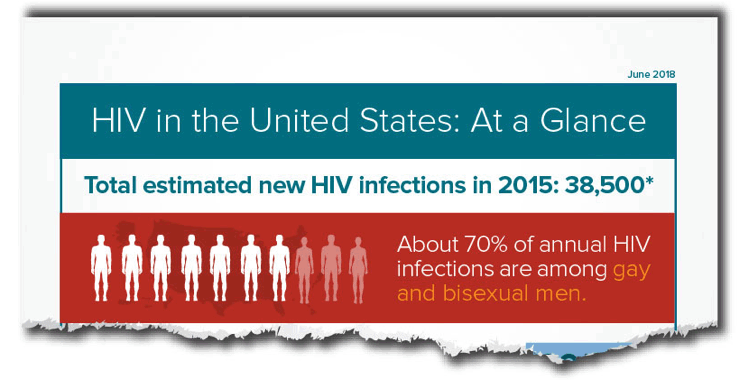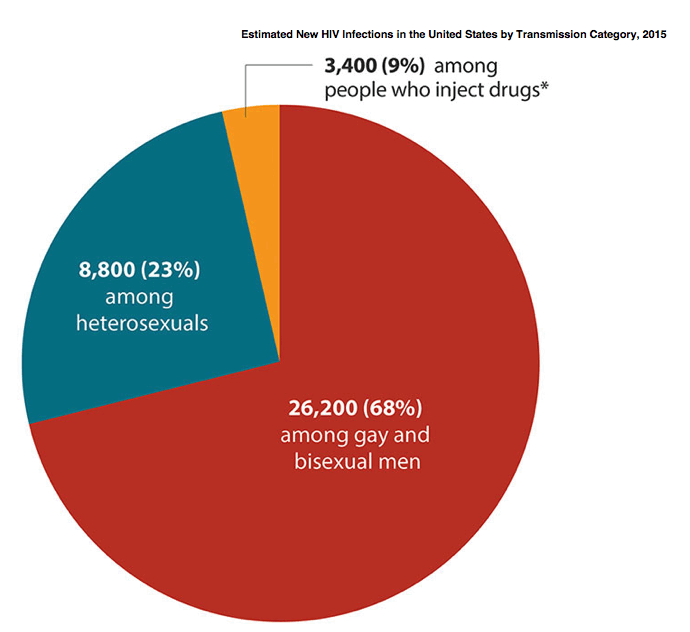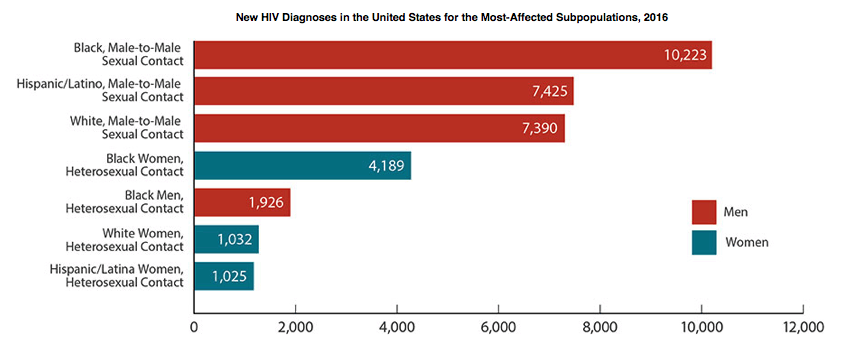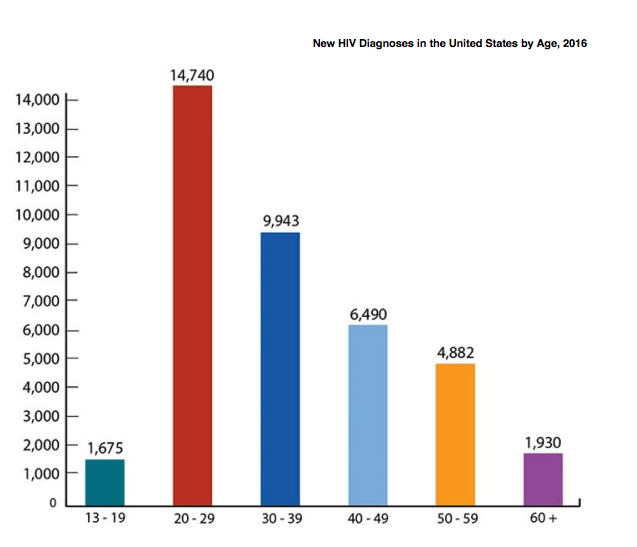| |
CDC - HIV in the United States: At A Glance
|
| |
| |
3 days ago Aug 2018
Annual HIV infectionsa and diagnosesb are declining in the United States. The declines may be due to targeted HIV prevention efforts. However, progress has been uneven, and annual infections and diagnoses have increased among some groups.
https://www.cdc.gov/hiv/statistics/overview/ataglance.html
HIV Infections
There were an estimated 38,500 new HIV infections in 2015. Among all populations in the United States, the estimated number of annual infections declined 8% from 2010 (41,800) to 2015 (38,500).

Download the Fact Sheet

Estimated New HIV Infections in the United States by Transmission Category, 2015
*Includes infections among gay and bisexual men who inject drugs and therefore have two risk factors.
Source: CDC. Estimated HIV incidence and prevalence in the United States, 2010-2015. HIV Surveillance Supplemental Report 2018;23(1).
HIV Diagnoses
In 2016, 39,782 people received an HIV diagnosis. The annual number of HIV diagnoses declined 5% between 2011 and 2015.

New HIV Diagnoses in the United States for the Most-Affected Subpopulations, 2016
Subpopulations representing 2% or less of all people who received an HIV diagnosis in 2016 are not represented in this chart.
Source: CDC. Diagnoses of HIV infection in the United States and dependent areas, 2016. HIV Surveillance Report 2017;28.
Gay and bisexual men are the population most affected by HIV. In 2016:
o Gay and bisexual men accounted for 67% (26,570) of all HIV diagnoses and 83% of diagnoses among males.
o Black/African Americand gay and bisexual men accounted for the largest number of HIV diagnoses (10,223), followed by Hispanic/Latinoe (7,425) and white (7,390) gay and bisexual men.
Trends among gay and bisexual men have varied by race. From 2011 to 2015:
o Among white gay and bisexual men, diagnoses decreased 10%.
o Among African American gay and bisexual men, diagnoses increased 4%.
o After years of sharp increases, diagnoses among young African American gay and bisexual men (aged 13 to 24) stayed about the same.
o Among Hispanic/Latino gay and bisexual men, diagnoses increased 14%.
Heterosexuals and people who inject drugs (PWID) also continue to be affected by HIV. In 2016:
o Heterosexual contact accounted for 24% (9,578) of HIV diagnoses.
o Women accounted for 19% (7,529) of HIV diagnoses (primarily attributed to heterosexual contact [87%, or 6,541] or injection drug use [12%, or 939]).
o PWID accounted for 9% (3,425) of HIV diagnoses (includes 1,201 diagnoses among gay and bisexual men who inject drugs).
From 2011 to 2015:
o Diagnoses among all women declined 16%.
o Among all heterosexuals, diagnoses declined 15%, and among PWID, diagnoses declined 17%.
By race/ethnicity, African Americans and Hispanics/Latinos are disproportionately affected by HIV. In 2016:
o African Americans represented 12% of the population, but accounted for 44% (17,528) of HIV diagnoses. African Americans have the highest rate of HIV diagnoses compared to other races and ethnicities.
o Hispanics/Latinos represented 18% of the population, but accounted for 25% (9,766) of HIV diagnoses.
HIV diagnoses are not evenly distributed geographically. The population rates (per 100,000 people) of people who received an HIV diagnosis were highest in the South (16.8), followed by the Northeast (11.2), the West (10.2), and the Midwest (7.5).g
New HIV Diagnoses in the United States by Age, 2016

Source: CDC. Diagnoses of HIV infection in the United States and dependent areas, 2016. HIV Surveillance Report 2017;28.
AIDS Diagnoses
In 2016, 18,160 people received an AIDS diagnosis. Since the epidemic began in the early 1980s, 1,232,346 people have received an AIDS diagnosis.
Living With HIV and Deaths
o An estimated 1,122,900 adults and adolescents were living with HIV at the end of 2015.
Of those, 162,500 (15%) had not received a diagnosis.
o Young people were the most likely to be unaware of their infection. Among people aged 13-24 with HIV, an estimated 51% didn't know.
o In 2014, among all adults and adolescents with HIV (diagnosed or undiagnosed),
- 62% received some HIV medical care,
- 48% were retained in continuous HIV care, and
- 49% had achieved viral suppression (having a very low level of the virus).h A person with HIV who takes HIV medicine as prescribed and gets and stays virally suppressed can stay healthy and has effectively no risk of sexually transmitting HIV to HIV-negative partners.
o From 1987 (the first year HIV was listed as a cause of death on death certificates) through 2015, 507,351 people died from HIV disease. In 2015, 6,465 people died from HIV disease.
a Estimated annual HIV infections are the estimated number of new infections (HIV incidence) that occurred in a particular year, regardless of when those infections were diagnosed. Incidence data are not available for all subpopulations.
b HIV and AIDS diagnoses indicate when a person is diagnosed with HIV or AIDS, not when the person was infected.
c The term male-to-male sexual contact is used in CDC surveillance systems. It indicates a behavior that transmits HIV infection, not how individuals self-identify in terms of their sexuality. This fact sheet uses the term gay and bisexual men.
d Referred to as African American in this fact sheet.
e Hispanics/Latinos can be of any race.
f In this fact sheet, PWID includes diagnoses attributed to injection drug use as well as those attributed to injection drug use and male-to-male sexual contact.
g Regions defined by the US Census Bureau and used in CDC's National HIV Surveillance System: Northeast: CT, ME, MA, NH, NJ, NY, PA, RI, VT Midwest: IL, IN, IA, KS, MI, MN, MO, NE, ND, OH, SD, WI South: AL, AR, DE, DC, FL, GA, KY, LA, MD, MS, NC, OK, SC, TN, TX, VA, WV
West: AK, AZ, CA, CO, HI, ID, MT, NV, NM, OR, UT, WA, WY
h People are considered retained in care if they get two viral load or CD4 tests at least 3 months apart in a year. (CD4 cells are the cells in the body's immune system that are destroyed by HIV.) Viral suppression (having less than 200 copies of HIV per milliliter of blood) is based on the most recent viral load test.
|
|
| |
| |
|
|
|